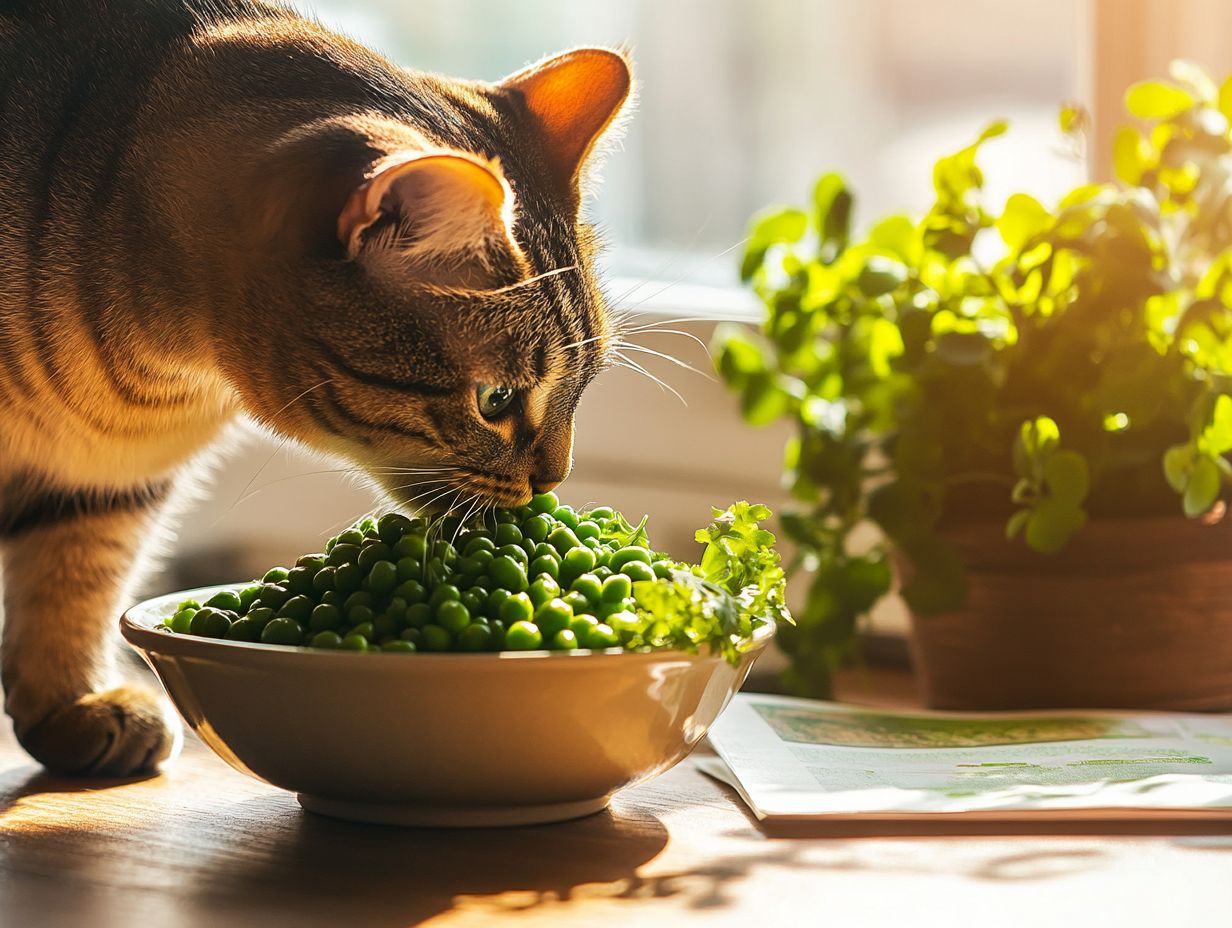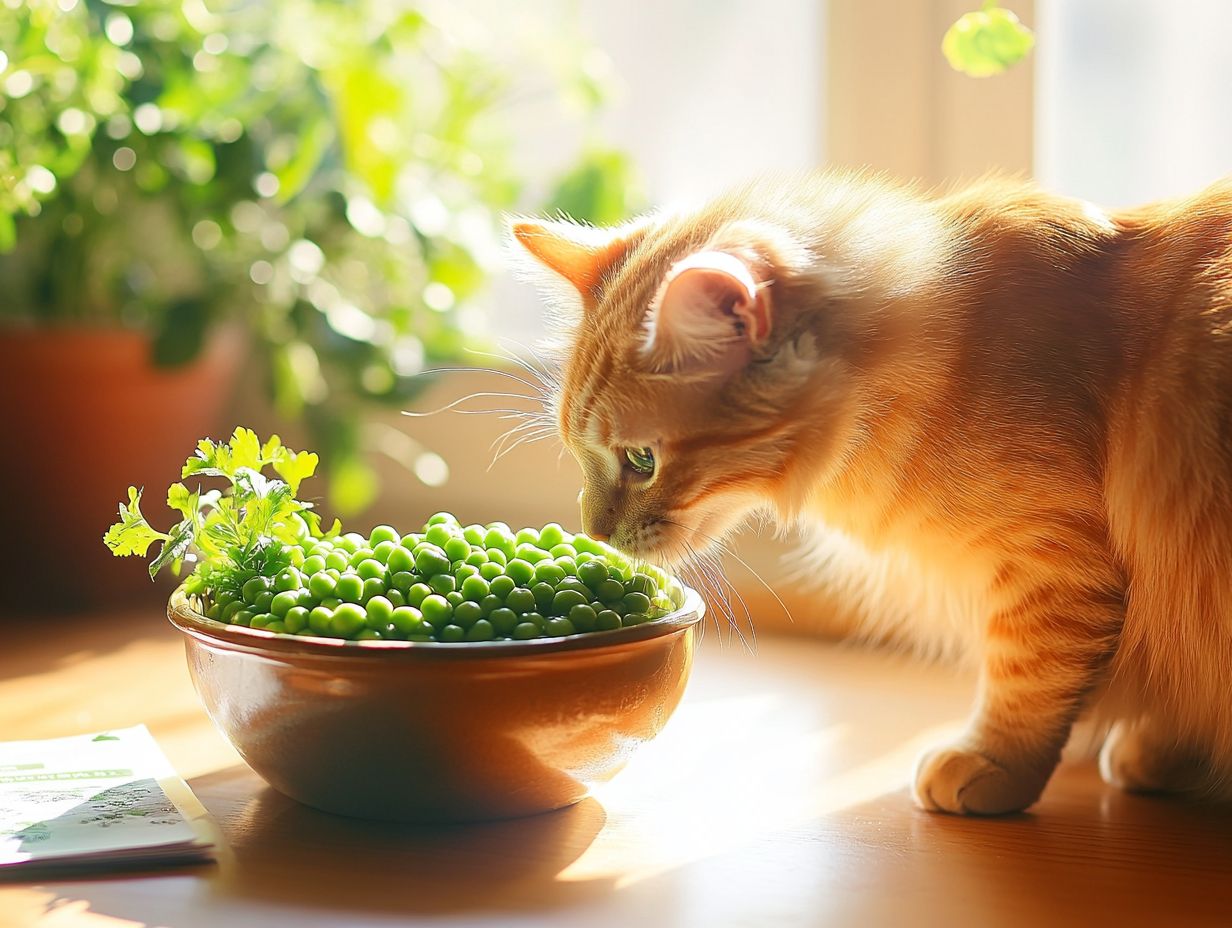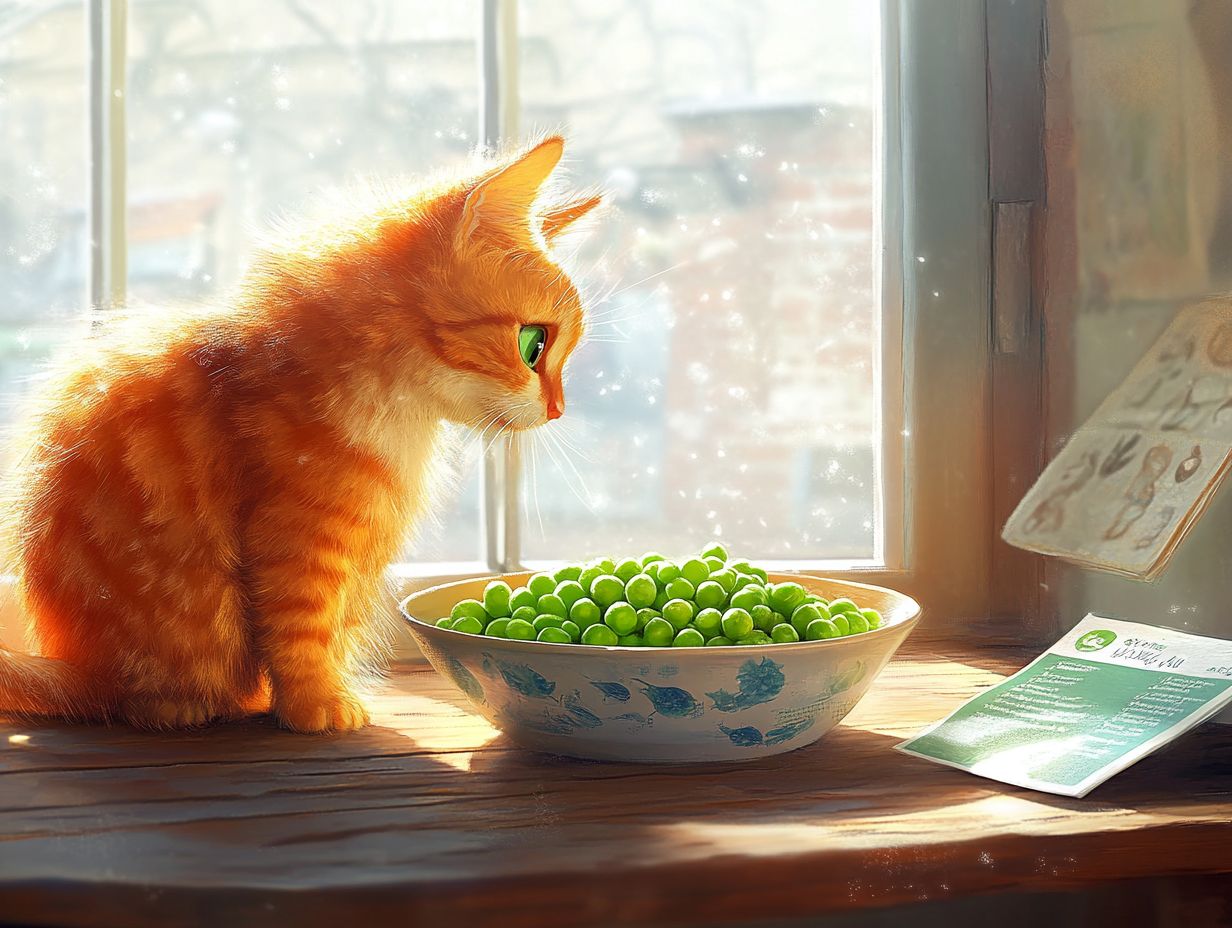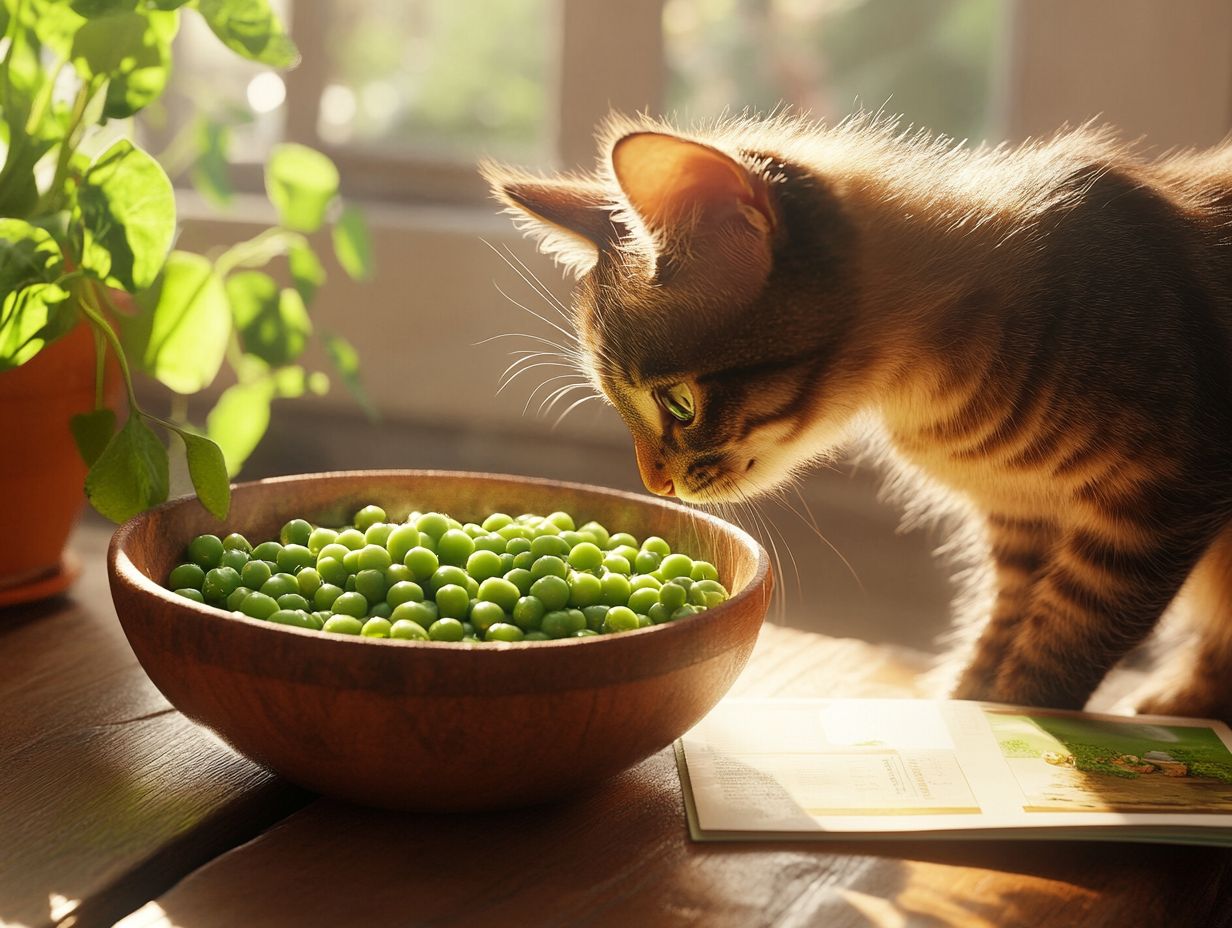Can cats safely eat peas? Many cat owners are exploring healthy food options, including human foods that are safe for cats, to boost their furry friends’ nutrition. While peas can be beneficial, they should not replace a cat’s primary protein source, which should come from animal-based proteins, to ensure a balanced diet.
This article examines the nutritional value of peas for cats, highlighting their protein, fiber, and essential nutrients, and discusses the broader topic of feline nutrition.
It also discusses potential benefits like digestive health and weight management while addressing possible risks, including allergies.
Additionally, you’ll learn how to safely incorporate peas into your cat’s meals and discover other nutritious treat alternatives, such as vegetables for cats and lean meats like cooked chicken.
Read on for all the details!
Key Takeaways:

- Peas can be a beneficial addition to a cat’s diet, providing essential nutrients like protein and fiber.
- Introducing peas to a cat’s diet can promote digestive health and help with weight management, but be cautious of potential allergies and digestive issues.
- Careful portion sizes and preparation methods should be followed when feeding peas to cats, and owners should also consider other healthy treat options for variety in their pet’s diet.
The Nutritional Value of Peas for Cats
Peas can be a beneficial food for cats, offering nutritional value and supplementing regular cat food. They provide proteins, fibers, and vitamins that contribute to a cat’s overall health.
Although cats need meat, foods like peas can help meet their dietary needs and support a well-balanced diet. Understanding the nutritional value of peas enables cat owners to make informed choices about the best foods for their feline companions.
Protein, Fiber, Potassium, and Other Essential Nutrients
Peas are an excellent source of protein and fiber, both of which are vital for a cat’s overall health and proper digestion. As a nutrient-dense legume, they provide essential amino acids that are crucial for muscle development and overall growth. Additionally, they are rich in potassium, supporting various bodily functions.
The fiber in peas supports a healthy gut by enhancing the function of the digestive tract, allowing a cat’s system to process food efficiently. Furthermore, soluble fiber in peas may help regulate blood sugar levels and provide sustained energy throughout the day.
Incorporating peas into a cat’s diet can lead to improved digestion and a more balanced nutritional profile, ultimately contributing to greater activity and vitality in a cat’s lifestyle.
Potential Benefits and Risks of Feeding Peas to Cats
- Feeding peas to cats offers several advantages, particularly in terms of digestive health and weight management, both key aspects of maintaining optimal feline health and meeting dietary needs.
- However, while rare, some cats may have allergies to peas. Monitor your cat for any adverse reactions when introducing new foods.
Supporting Digestive Health

The fiber content in peas can enhance cats’ digestive health by promoting regular bowel movements and preventing digestive issues. Research indicates that pea consumption in cats and dogs can help regulate blood glucose levels, assist with weight management, and support digestive health by maintaining a healthy gastrointestinal tract, which is vital for overall cat health.
Veterinary professionals often recommend fiber-rich diets to address issues such as constipation, which can cause discomfort and lead to serious health problems if left untreated.
Fiber plays a crucial role in regulating food movement through the intestines, adding bulk to the stool, and facilitating regular digestion. A study titled “Evidence of the Health Benefits of Peas as Possible Functional Ingredients in Pet Food,” published in the journal Animals, found that incorporating peas and other sources of dietary fiber can contribute to a balanced diet, making it easier for cats to maintain digestive regularity.
Knowing that a cat is receiving an adequate amount of fiber daily allows caregivers to feel confident that they are supporting their beloved pets’ health.
For portion sizes, start with a teaspoon of cooked peas for small cats and adjust as necessary. Always consult with a veterinarian before making significant dietary changes for your pets.
Assisting with Weight Management
If you’re wondering whether peas can help manage your cat’s weight, here’s what you need to know. Peas can aid in weight control for cats because they provide a low-calorie snack full of nutrients that helps satisfy a cat’s appetite. These small green legumes are packed with essential vitamins and minerals and offer a satisfying crunch that many cats enjoy.
However, cat owners should remember that while peas make for a wonderful occasional snack, they should never replace a balanced regular diet. Snacks should complement a cat’s main food; otherwise, the cat may miss out on essential nutrients or consume excess calories, potentially leading to obesity.
By carefully measuring out peas as an additional snack, pet owners can help manage their cat’s weight while also providing enrichment and enjoyment.
Possible Risks of Feeding Peas to Cats
Warning: Monitor for Allergies and Digestive Upset. While peas provide numerous benefits, there are potential risks associated with feeding them to cats, including allergies and digestive issues resulting from various food intolerances.
Allergies and Digestive Issues
Cats can develop allergies or digestive problems when they consume peas, especially if they have other food intolerances. Additional reactions may manifest as gastrointestinal upset, itching, or other skin irritations.
It is crucial for cat owners to monitor any changes in their pet’s behavior, appetite, or overall health after altering or supplementing their regular diet. Veterinarians recommend introducing any new ingredient, including peas, gradually and in small amounts to assess the cat’s tolerance, particularly when dealing with food allergies or intolerances.
Symptoms such as vomiting, diarrhea, or increased scratching should be closely observed to identify any negative reactions early on.
How to Safely Incorporate Peas into a Cat’s Diet

Feeding peas to cats should be done in moderation and with appropriate preparation to ensure the food is both palatable and easily digestible.
Understanding how to serve peas to cats is crucial for their enjoyment and overall well-being.
Proper Portion Sizes and Preparation
Appropriate portion sizes are crucial when feeding peas to cats to ensure they receive the health benefits without overeating. Start with 1-2 peas for small cats and 3-5 peas for larger ones. Cats vary significantly in size and dietary requirements, so the amount offered should be based on their weight, dietary restrictions, and overall health.
For instance, a smaller cat may only need a few peas, while a larger cat might be able to tolerate a bit more. The best approach is to start with a small quantity and observe how the cat responds before making any adjustments.
Steaming or lightly mashing the peas can make them easier for a cat’s digestive system and help preserve their nutritional properties. Additionally, avoiding any seasoning allows the natural taste of the peas to shine, which is more suitable for their dietary needs. Always watch for choking hazards, especially for cats that tend to gulp food quickly.
Other Healthy Treat Options for Cats
There are many other healthy treat options besides peas that can meet a cat’s dietary needs and provide nutritional variety, ensuring they receive a balanced diet.
Alternatives to Peas for Nutritional Variety
The best alternatives to peas for providing nutritional variety for cats include cooked meats, various types of fish, and certain safe vegetables. These alternatives serve as excellent sources of protein essential for optimal health, as well as vitamins and minerals that contribute to overall well-being.
For instance, cooked chicken or turkey offers lean protein and amino acids important for muscle growth and energy. Fish varieties like salmon and tuna are rich in healthy omega-3 fatty acids, which promote healthy skin and coat while supporting heart health.
Vegetables such as carrots and pumpkin can add fiber to a cat’s diet while supplying a range of nutrients. Each of these options can be incorporated into meals or given as healthy snacks, ensuring a varied and nutritious diet that keeps cats active and happy.
Frequently Asked Questions

Can cats eat peas?
Peas can be a healthy addition to a cat’s diet, but they should remain a supplement, not a replacement for a balanced diet. Always consult your veterinarian before adding new foods to your cat’s diet and observe your pet for any adverse reactions.
Are you wondering if peas are safe for your feline friend? Yes, cats can eat peas in moderation. However, they are not a necessary part of a cat’s diet and should not make up a large portion of their meals.
Are peas safe for cats to eat?
Yes, peas are generally safe for cats to eat. However, it’s important to note that some cats may have allergies or sensitivities to certain foods, including peas. Signs of food allergies in cats can include vomiting, diarrhea, or skin issues. Always seek veterinary advice when introducing new foods.
- Peas are generally safe for most cats.
- Monitor for any signs of allergies such as vomiting or diarrhea.
What nutritional benefits do peas provide for cats?
Peas are a good source of fiber and protein, which can help with digestion and muscle maintenance in cats. They also contain vitamins A, B, and K, as well as minerals like iron, magnesium, and potassium. Always verify the nutritional claims about peas with trusted veterinary sources for accuracy.
- Good source of fiber and protein.
- Contains vitamins A, B, K and minerals like iron, magnesium, and potassium.
Can cats eat frozen peas?
While it’s generally okay for cats to eat frozen peas, it’s best to cook them first to make them easier to digest. Steam peas until soft rather than boiling to retain nutrients. Raw or frozen peas may be harder for cats to chew and could potentially cause digestive issues.
- Steam peas until soft for easier digestion.
- Avoid feeding raw or frozen peas directly.
How should I feed peas to my cat?
If you plan on giving your kitty cat peas, it’s important to do so in moderation and as a healthy treat rather than a main part of their diet. A good guideline is to feed about a teaspoon of cooked peas for every 5 pounds of body weight once a week. Peas can be mixed in with their regular cat food or served cooked as a standalone treat, which adds nutritional value to their diet.
- Moderation is key; consider a teaspoon of cooked peas for every 5 pounds of body weight once a week.
- Can be mixed with regular cat food or served as a treat.
Are there any risks associated with feeding peas to cats?
In general, peas are safe for cats to eat. However, if your cat has any underlying health issues or is on a specialized diet, it’s best to consult with a veterinarian before introducing peas into their diet. Some cats may experience gas or diarrhea if they consume too many peas at once. Vegetables for cats, like peas, can be a good addition to their diet but should be given in moderation. Additionally, always monitor your cat’s reaction to new foods and discontinue if any negative symptoms occur. Consulting with veterinarians can help you understand your cat’s dietary requirements and avoid harmful foods.
- Potential digestive issues if consumed in excess.
- Consult your veterinarian for personalized feeding advice.